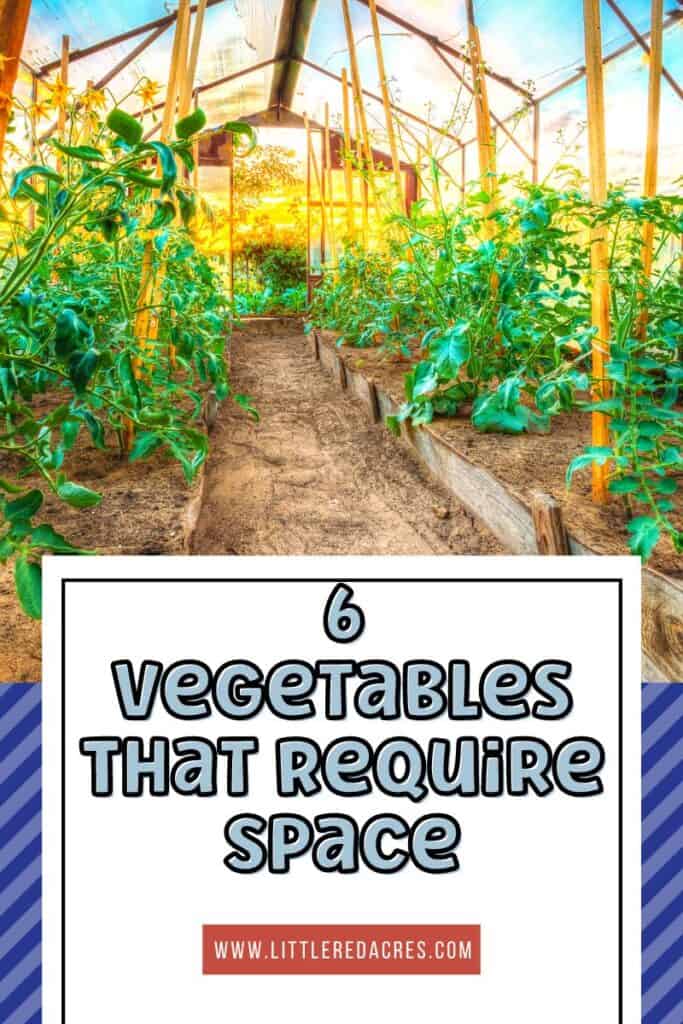6 Vegetables That Require Space to Grow
Inside: Here are six vegetables that require space to grow properly and give you a great harvest. Some vegetables have specific requirements.
When it comes to growing vegetables, giving them adequate space to flourish is essential for their healthy development. Some vegetables have specific requirements and need ample room to grow and spread their roots. Here are six vegetables that require space to grow properly and give you a great harvest.

This post may contain affiliate links, see my disclosure policy for more information.
6 Vegetables That Require Space to Grow
Whether you have a small backyard garden or a large plot of land, understanding the needs of these vegetables will help you optimize your gardening efforts and maximize your harvest. It's always about maximizing your harvest. Work smarter, not harder for the best yield.
Get updates & freebies delivered to your inbox!
Pumpkin
Pumpkins are a favorite among gardeners, especially during the fall season. These robust vines produce large, vibrant orange fruits that are perfect for carving or making pies.
However, pumpkins require ample space to sprawl and grow. Each plant should ideally have a minimum of 50 square feet of space to allow for the spread of the vine.

Cabbage
Cabbage is a nutritious and versatile vegetable commonly grown. This leafy green belongs to the brassica family and requires space for its dense head to develop fully.
Plant cabbage seedlings at least 18 to 24 inches apart to ensure sufficient airflow and sunlight exposure.

Squash
Squash, including varieties like zucchini, butternut, and acorn squash, requires adequate space to produce an abundant harvest. These sprawling vines need room to spread, so allocate approximately 4 to 6 feet between each plant.
Additionally, you can train the vines to grow vertically using trellises or supports, which not only saves space but also promotes healthier plants and easier harvesting.

Brussels Sprouts
Brussels sprouts are a cold-hardy vegetable that thrives in Canadian climates. These miniature cabbages develop along a tall stem, making ample spacing crucial for proper growth.
Plant Brussels sprouts about 24 to 36 inches apart, allowing adequate room for the tall stalks to develop and support the weight of the sprouts. Providing enough space also ensures that the plants receive enough sunlight, resulting in sturdy and flavorful sprouts.

Broccoli
Broccoli is a nutrient-rich vegetable known for its distinctive green florets. To encourage robust growth and sizeable heads, broccoli plants need adequate space to breathe and develop. Aim for spacing of around 18 to 24 inches between plants, allowing for proper airflow and sunlight penetration.
Crowded broccoli plants can be susceptible to fungal diseases, so providing sufficient space aids in disease prevention as well.

Tomatoes
Tomatoes are a staple in many gardens, and they require ample space for optimal growth and fruit production. These sprawling vines need support and should ideally be staked or caged to keep them off the ground.
Allow approximately 2 to 3 feet of spacing between tomato plants, providing enough room for air circulation and sunlight exposure. You can prune tomato plants to keep their size under control, and to make sure the plant is putting its energy into growing fruit not just growing bigger.

Giving your vegetables adequate space to grow is crucial for their overall health and productivity. By understanding the spatial requirements of specific vegetables, such as pumpkins, cabbage, squash, Brussels sprouts, broccoli, and tomatoes, you can create an environment that allows them to thrive.
Whether you have a small garden or a large plot, optimizing spacing between plants ensures proper airflow, sunlight exposure, and disease prevention. By following these guidelines, you'll be well on your way to a bountiful harvest of healthy, vibrant vegetables in your Canadian garden. Happy gardening!
Frequently Asked Questions
What vegetables need the most space to grow? Cucumbers and squash plants will also need a large container to grow in.
What vegetables grow in limited space? Choose plants that will still have a high yield when grown in small spaces: pole and runner beans, tomatoes, beets, peppers, peas, kale, zucchini, lettuce, and salad leaves will produce without abundant room.

Want More?
9 Reasons to Grow Heirloom Vegetables
A Beginner’s Guide to Pressure Canning Vegetables






